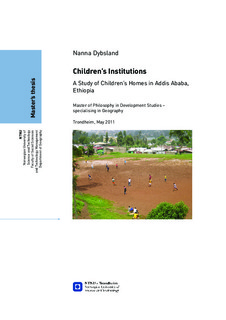| dc.contributor.advisor | Brun, Cathrine | nb_NO |
| dc.contributor.author | Dybsland, Nanna | nb_NO |
| dc.date.accessioned | 2014-12-19T14:26:07Z | |
| dc.date.available | 2014-12-19T14:26:07Z | |
| dc.date.created | 2012-08-02 | nb_NO |
| dc.date.issued | 2011 | nb_NO |
| dc.identifier | 542674 | nb_NO |
| dc.identifier.uri | http://hdl.handle.net/11250/265421 | |
| dc.description.abstract | The issues that children in Ethiopia face are some of the most challenging in the World. The situation for millions of Ethiopian children can only be described as a crisis. As a result many thousands of Ethiopian children have been placed into institutions because their parents are either no longer living or are unable to care for them.
The study sought to focus on children’s institutions. Specifically, the study aimed at discovers how children’s institutions were built up and organized. How the institutions are making a home for children, and what limitations and opportunities children get by staying in the children’s homes. The study was conducted in Addis Ababa, Ethiopia. Primary- data was collected through interviews and observation, and secondary-data from various sources were used.
Results show there is a great difference in how children’s homes in Addis Ababa are built-up and organized. To distinguish between the different children’s homes theory of total institution were used differences are in what kind of fences, guards and how the children’s homes were looking. The study shows that there are numerous sad stories from the children’s homes, but there are also stories of attachment and belonging. For the children growing up in institutional care in Ethiopia there will be limitations for moving around on their own. However, there are also opportunities for children in institutions compared to other children in Ethiopia. Children in institutions have a better chance of getting an education than children growing up in a low-income family.
This study recommends that further emphasis be given children in institutions and their needs. In the Ethiopian context there is a great need of improving and focusing on the alternative solutions since children in institutions will never be a recommended solution. However, for children in institutions there is a need of improving their stay to be as good as possible. The focus of improving children with the basic needs should also provide them with emotional needs, of love, care and emotional support. Since many of the children are suffering from a harsh background there is a need of improving the emotional support given to those children suffering from their background. | nb_NO |
| dc.language | eng | nb_NO |
| dc.publisher | Norges teknisk-naturvitenskapelige universitet, Fakultet for samfunnsvitenskap og teknologiledelse, Geografisk institutt | nb_NO |
| dc.subject | Social and Behavioural Science, Law | en_GB |
| dc.title | Children’s Institutions: A study of Children’s Homes in Addis Ababa, Ethiopia | nb_NO |
| dc.type | Master thesis | nb_NO |
| dc.contributor.department | Norges teknisk-naturvitenskapelige universitet, Fakultet for samfunnsvitenskap og teknologiledelse, Geografisk institutt | nb_NO |
